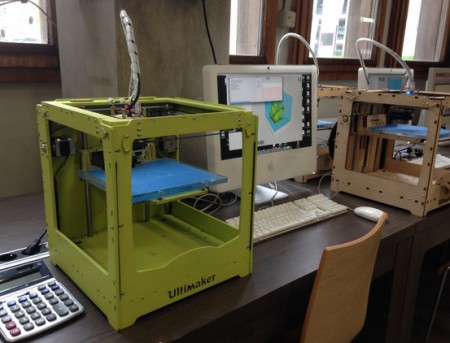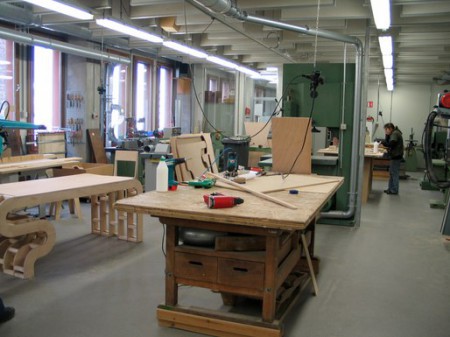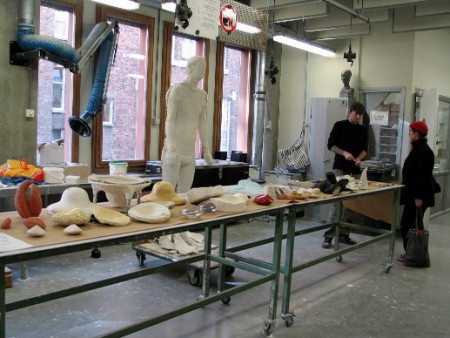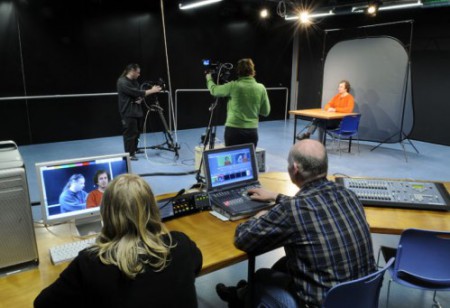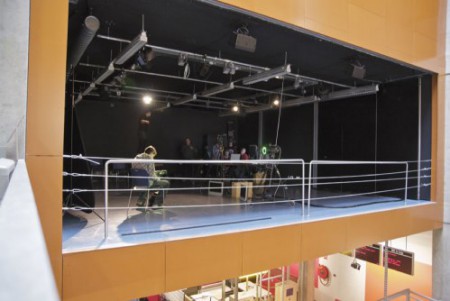The Master Fine Art (MFA) studios are housed at the Karel Doormanhof 45, Rotterdam. The students and staff have 24 hour access to the building.
From 2017, the Interior Architecture: Research + Design (MIARD); Lens-Based Media (LB), Experimental Publishing (XPUB) and Education in Arts (MEiA) are based on the 4th Floor of the WDKA, Located on Wijnhaven 61. The students and staff are given access to the building outside WDKA opening hours. On Saturdays and Sundays, the building will be open for PZI students through a second and smaller entrance at Wijnhaven 61, which leads directly to the 4th Floor.
Besides this, all students have access to a wide variety of stations, workshops and technical assistance.
STATIONS
What is a Station?
Students, instructors and teachers work in and around the Stations: main central hubs which provide Students, instructors, and tutors work in and around the stations: nodes where knowledge and relevant, high-value instruments are collected. Only when lights go out here, the whole WdKA will go to sleep. Stations are not the ‘property’ of any particular major or practice but are rather a meeting place for students and teachers across subjects and years. At the stations, you can find the facilities and expertise that you need to carry out your work. Their expertise covers software, hardware, technology, equipment, and machinery. Tutors, instructors, and student assistants are present at the stations all day – and in the evening – to help you.
The Stations are:
- Business Station
- Drawing Station
- Education Station
- Fabric Station
- Image & Sound Station
- Interaction Station
- Material Station
- Publication Station
- Research Station
- Bluecity Lab
What can you do at a station?
You take lessons and instruction while working on your regular quarterly projects. Outside these projects, you can work independently at the stations. You can also choose from a diverse range of instruction sessions and courses. This will allow you to familiarise yourself with particular technologies and equipment and to be able to use them in ways that are uniquely your own. You can learn techniques that are of interest to you and develop the skills that you are interested in or that complement the projects that you have chosen.
A station as knowledge-domain
Research is done at stations into new developments and innovations in the worlds of technology, art, and design. The application of new technologies is under constant scrutiny, and students learn to be aware of current technologies and how to make well-founded decisions on how to apply these technologies. This seamlessly complements the premise that, during your studies at the Academy, you learn by doing and then reflect on what you have done. The stations are an environment in which making and doing – and of course thinking – are encouraged and supported. You do not only work with your fellow students and tutors from your major, but also with students and tutors from other majors and years. Here you find state-of-the-art facilities and expertise to carry out your work: software, hardware, technology, equipment, and machinery.
Business Station
Connecting design & business
In the Business Station you learn to find your way to connect to the world outside of the academy. Make impact with your work, by connecting and acting on values and business context awareness. Discover how to control and lead within competitive markets, both nationally and internationally.
In addition to specific programmes and modules, the Business Station offers a wide range of activities about entrepreneurship and events related to starting your own business.
Drawing Station
In the Drawing Station, students learn “the language of drawing”. Also in a time of digital media, drawing is a direct and elementary way of visualisation, it is a basic skill. In the Drawing Station, the elaboration of an idea into a visual (communicative) concept is central.
As a student in the Drawing Station you do visual research and work on your projects. You learn to draw in the broadest sense of the word; we aim at the Drawing Station for the development of creative identity through visual experimentation and research.
This is a Station where marks are made, seeing is made visible, whether it’s the start of an idea or the end of a project. Our aim is to extend to all of the academies creative disciplines, Majors, practices and in all stations. Drawing and visual language is simultaneously ubiquitous, critical and invisible. This Station is a starting point for a line of enquiry in to visual awareness and technical skill both digitally and traditionally but critically in the overlap from these spheres.
In short: We Draw On All Disciplines.
Education Station
The Education Station is the centre of our learning community within WdKA. We collect and distribute knowledge, and stimulate new initiatives related to teaching and art education for students, instructors, coaches, teachers, and staff members. In addition to our specific programmes, we offer activities, and events about art education.
Activities
- student project support
- student electives on art education
- open lectures on education
- brown bag lunches – inclusive pedagogy
- English language training
- teacher training programs
- assessment-training-program
- support and development of mywdka.nl
- support of the Drive & Development weeks
- events & collaborations on art education
Fabric Station
At the Fabric Station we offer a vast collection of machines, tools and techniques.
We have a Fabric Station team of five instructors and currently a PAL, each with his or her specialism. Please contact one of us if you have any requests, questions or if you would like to make an appointment or would like to collaborate.
For the most up to date schedules of the Fabric Station you go to Planning en Reservations on mywdka.nl.
Image & Sound Station
The image&sound station offers facilities for time-based storytelling,
starting with log lines and first takes, up to ‘final mastering’ and screening,
from photogram to technical camera, from hand drawn cell animation up to
CGI and gaming.
In this station students will acquire skills in a technical sense as well as content wise,
they get to know different media types, learn to use and experiment with them.
The image&sound station merges the former workshops on
animation, audio-visual and photography, including photo-, video- and audio studio’s,
a large dark room and digital post production seats.
Added components would be the newer narrative platforms like mobile media,
the ‘fourth screen’, smartphones and tablets together with the deviceLab, publicationStation and the interactionStation,
aiming at the transforming narrative structures in these days of digital media,
focussing on analysis and design; linear, non-linear, transmedial or different…
Interaction Station
The core of the Interaction Station is behaviour design, with the main components interaction and interface design. In a time of the ubiquity of computers and digital networks – “the internet of things” / ubiquitous computing – designing interaction becomes ever more complex. This station covers the development of both software and hardware interfaces. How to design behaviour and what systems are at it’s base?
The Interaction station provides space for research and experimentation regarding the entire process of interaction; from thinking in systems to usability and from interaction and interface design for Arduino’s to gestural interfaces such as the Wii. Students learn to question and approach existing technologies critically, and acquire the skills to make them their own.
- What can you do here?
Build and test interactive sound and/or video installations - Get acquainted with new technologies such as Virtual & Augmented Reality, and Internet of Things
- Build prototypes using a lasercutter and / or 3d printer
- Work on (wearable) electronics projects
- Get help to develop your ideas into actual working projects
- Get skilled in web development, and other networked projects
Material Station
The material station is focused on material innovation and fabrication, mostly in metal, wood, ceramics and digital fabrication. Hands on you will meet the different materials and techniques. The material station has a lot of tools/ machines for working with ceramics/ plastics, wood, metal and several digital techniques.
Publication Station
Within the Publication Station there is a focus on reproduction, publication and presentation on print and digital media.
In addition to the open project spaces where tutors can give their lessons and where students can work individually the station has the following workshops:
• A printmaking studio containing the bookbinding and printmaking machines (etching, litho, high-pressure / letterpress, silk screen, riso print).
• A Print Studio focusing on large-format inkjet printing and printing on different materials.
• A Device Lab where devices are available to develop and test digital digital publications and e-publishing.
Research Station
Thinking about and reflecting on what research means for a visual artist and/or a designer
The Research Station’s purpose is to encourage applied research – research shaped by a complex mixture of speculative thinking, studying theories, experimenting and reflecting. It is a place for sharing your research ideas, a place for inter vision, debating and presenting. This is where research is presented in the form of publications, documents and exhibitions of best practices.
The Research Station is the place where research is made visible.
In the Research Station you can:
Develop basic research skills: find information, explore and investigate, write and read assignments, and formulate research questions using visual sources.
Develop research skills relevant to your own context, for example observational and interviewing techniques.
Familiarise yourself with methods of design research and artistic research, such as prototyping, culture probing and data mapping.
Learn the research skills necessary for reflecting upon your work.
BlueCity
BlueCity is an exemplary city for the circular economy in which entrepreneurs connect their residual flows to each other, making waste a valuable raw material. Collaboration, thinking and doing is essential. An important role is played by the BlueCity Lab.
The Lab is located in the old changing rooms of the former tropical swimming paradise Tropicana and consists of a wet lab and dry lab; in the long term, an experimental kitchen will also be added. Thanks to this unique combination, the only one in the Netherlands, materials can be grown from the cell in the wet lab and then processed into the end product in the dry lab. A packaging material of oyster mushroom mycelium for example, or a bag of kombucha leather, made from bacteria and yeasts, coloured with bacterial ink – all developed in the Lab.

